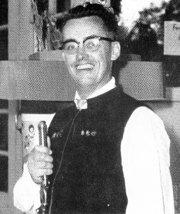
|
Folk Dance Federation of California, South, Inc.
Historical Notes |

|
CLICK IMAGE TO ENLARGE
As an oldtime dance found generally throughout Sweden for well over a century, the Schottis has understandably acquired many localized forms, which, when collected in these latter days acquire the status of a "bygdedans" (regional ethnic dance). To date, there are published variants from Idre, Bingsjö, Lima, Transtrand, and Särna, in the province of Dalarna; Haverö in Medelpad; Viksta in Uppland, Årsunda in Gästrikland; and Schottisvägen from Karlskogatrakten. They all have many things common, but local interpretations – "dialect," if you will – give each of them a distinctive character.
Styles vary not only between districts, but within a given district as well. Therefore, it is not unusual to find dancers using a variety of dance holds on both the open and closed positions of such a dance as the Schottis. For the older form, Gammal schottis, the closed basic polska hold (see below) is generally favored. An interesting variation is often used in the basic form, however: on the pivot-spin turn, the W L hand remains joined with the M R hand, being held in the center of the W back, rather than disengaged and brought up to the M upper arm as in the normal polska hold (a closed position). Thus, the ptrs inside hands are kept in contact throughout the entire pattern – a rather nice feeling!
In contrast to the common "physical education class" schottische with its "1,2,3,hop" flamboyance, the old Swedish schottis is a rather elegant dance, reserved, and dignified. But not without a sense of real power on the rotation. The essential difference between the ordinary "garden variety" schottis, and the Gammal schottis, in all its variants, is something called "svikt" (springiness), that lilting quality found in the latter, older form. Knees are flexed throughout so there are no sharp movements. On the "soft" schottische step, the hop or skip on the 4th ct is replaced by a gentle lifting of the free ft. And, in keeping with the overall style, the turn is danced without a semblance of a hop! The key word is "legato" (smooth).
The importance of proper music for this and other ethnic-style dances cannot be overstressed. If the dance is to be performed "legato," the music must be played "legato," so the choice of recordings becomes critical. Oldstyle Swedish fiddling, which has perpetuated an ancient legato playing technique, is especially recommended.
Basic Polska Hold
(A closed position)
M R arm around W waist, M L hand on W upper arm just below her shldr; W L arm on M upper arm, and W R arm on the inside of M L arm, with her R hand just below shldr. Ptrs are slightly to the L of each other; M R ft between W ft.
Reprinted from the 1980 University of the Pacific (Stockton) Folk Dance Camp syllabus.